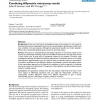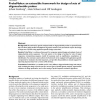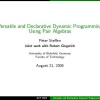BMCBI
2005
13 years 11 months ago
2005
Background: As the use of microarray technology becomes more prevalent it is not unusual to find several laboratories employing the same microarray technology to identify genes re...
BMCBI
2005
13 years 11 months ago
2005
Background: To facilitate efficient selection and the prioritization of candidate complex disease susceptibility genes for association analysis, increasingly comprehensive annotat...
BMCBI
2005
13 years 11 months ago
2005
Background: All eukaryotic organisms need to distinguish each of their chromosomes. A few protein complexes have been described that recognise entire, specific chromosomes, for in...
BMCBI
2005
13 years 11 months ago
2005
Background: Procedures for genetic analyses based on oligonucleotide probes are powerful tools that can allow highly parallel investigations of genetic material. Such procedures r...
BMCBI
2005
13 years 11 months ago
2005
BMCBI
2005
13 years 11 months ago
2005
Background: We introduce GASH, a new, publicly accessible program for structural alignment and superposition. Alignments are scored by the Number of Equivalent Residues (NER), a q...
BMCBI
2005
13 years 11 months ago
2005
Background: Complex biological database systems have become key computational tools used daily by scientists and researchers. Many of these systems must be capable of executing on...
BMCBI
2005
13 years 11 months ago
2005
Background: Whole-genome sequencing projects are rapidly producing an enormous number of new sequences. Consequently almost every family of proteins now contains hundreds of membe...
BMCBI
2005
13 years 11 months ago
2005
Background: Distance-based methods are popular for reconstructing evolutionary trees thanks to their speed and generality. A number of methods exist for estimating distances from ...





